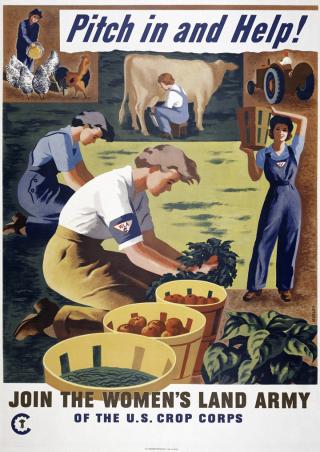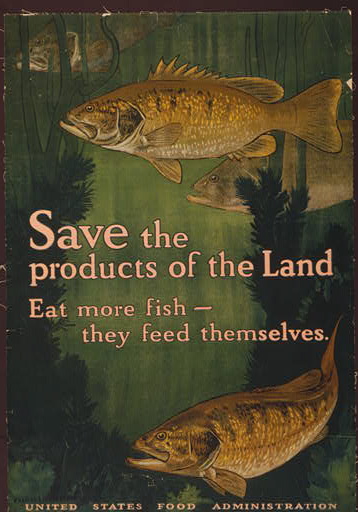How Did The Food Administration Support The War Effort
Ad A FDA Expert Will Answer You Now. Supplies such as gasoline butter sugar and canned milk were rationed because they needed to be diverted to the war effort.
Food Conservation During Wwi Together We Win
Phrases such as Food Will Win the War Save It Dont Waste and Americas Food Pledge were the common themes used in promoting the war effort on food.

How did the food administration support the war effort. His efforts paid off because food exports to the Allies tripled. Government established a Committee on Public Information CPI to involve the nation in the war effort. The United States Food Administration USFA urged families to reduce consumption of key staples to help the war effort and avoid rationing.
Maintain governmental power over foods by using voluntary agreements and a. Army As young men fought in the trenches of Europe housewives across America were called upon to do their duty by minding the pantry keeping down food waste and foregoing the bounty of our amber. Agricultural contributions were increasingly incorporated into multinational responses through such entities as the United Nations Relief and Rehabilitation Administration UNRRA and the UN Food and Agricultural Organization Organization.
Herbert Hoover coordinated the Food Administration and he too encouraged volunteer rationing by invoking patriotism. During the First World War the amount of food consumed in the United States between 1918 and 1919 was reduced by 15 due to the wartime food conservation efforts. One week after entering the war in April 1917 the US.
Food aid did not become an ingrained element of US. Food Administration operating in each state was to. Food Administration was gradually dismantled until an Executive Order of August 21 1920 terminated all branches of the Food Administration still in existence.
On August 10 1917 shortly after the United States entered the war the US. Herbert Hoover coordinated the Food Administration and he too encouraged volunteer rationing by invoking patriotism. Chambers was issued by the United States Food Administration to encourage voluntary food conservation.
Food Administration was the agency responsible for the administration of the US. This colorful poster by artist Charles E. Food production and agriculture were essential parts of Canadas war effort and Ottawa encouraged farmers and food processors to maximize their output.
After the War ended the US. But eating less fat was not for weight loss. However civilians were encouraged to do their part for the war effort during World War I as well.
For example the Japanese Imperial Army controlled the Dutch East Indies todays Indonesia from March 1942 to September 1945 creating a shortage of rubber that affected American production. It was so fats would be available for the war effort. When most people think of wartime food rationing they often think of World War II.
When most people think of wartime food rationing they often think of World War II. World War I ended on November 11 1918 and thus so did the activities of the US. With the slogan food will win the war Hoover encouraged Meatless Mondays Wheatless Wednesdays and other similar reductions with the hope of rationing food for military use.
Assure the supply distribution and conservation of food during the war. Questions Answered Every 9 Seconds. Conserving food would support US.
Americans- Short Wheat Crop Needs Careful DistributionHerbert Hoover United States Food Administrator 4-P-74 NAID Identifier 512513 Spirit of 18. One of its important tasks was the stabilization of the price of wheat on the US. Foreign policy and diplomacy until after the Second World War.
The World Cry Food. Army overseas and allies food reserves during the United States participation in World War I. Each was a campaign from the US.
Food Administration was established to manage the wartime supply conservation distribution and transportation of food. During World War I US President Woodrow Wilson issued a proclamation calling for every Tuesday to be meatless and for one meatless meal to be observed every day for a total of nine meatless meals each week. Chambers was issued by the United States Food.
Food Administration during World War I and the food propaganda it represented was as important to the war effort as Uncle Sams I want YOU for the US. Use of food through effective production consumption and preservation was presented by the government as patriotic acts to help the troops and the nation. However civilians were encouraged to do their part for the war effort during World War I as well.
The Administration promoted using less oil by baking broiling and boiling food rather than frying. This colorful poster by artist Charles E. -supervised efforts to reduce food consumption using the slogan Food Will Win the War--Dont Waste It-families were encouraged to Hooverize by serving just enough and by having Wheatless Mondays and Meatless Tuesdays-encouraged people to consume less food so there is more for the military-also promoted victory gardens.
Food Administration advocated Americans conserve fats. Food Administration headed by Herbert Hoover in its drive to feed the troops and ensure an adequate food supply for the civilian population at home and abroad. Food Administration and the Pennsylvania Food Conservation Train.
Facilitate transportation of food and prevent monopolies and hoarding. The committees materials included a poster campaign designed to help the US. 1918 The Food Administration begins a campaign to get Americans to make voluntary changes to their diet by instituting Wheatless Wednesdays and Meatless Mondays November 11 1918 An armistice ends the fighting in World War I.
With the slogan food will win the war Hoover encouraged Meatless Mondays Wheatless Wednesdays and other similar reductions with the hope of rationing food for military use. On September 18 1917 a Wisconsin state politician named Magnus Swenson suggested the institution of Meatless Tuesdays to decrease meat consumption in the state. Historians estimate that by 1943 up to 20 million victory gardens were cultivated helping sustain the needs of the country.
To facilitate this process the United States Food Administration was established and led by future President Herbert Hoover. In the mid-1940s US. War also disrupted trade limiting the availability of some goods.
The Expansion of Agriculture Agricultural production grew rapidly in response to federal urging international scarcity and high prices. Food Will Win the War 1917 When most people think of wartime food rationing they often think of World War II. People were encouraged to follow Meatless Mondays and Wheatless Wednesdays in an effort to both unite the general public behind the war effort and furnish these essential resources to the allied nations.
Hoover asked for Ameicans to voluntarily give up meat on Tuesdays and wheat on Mondays to have extra food to export for the war effort.

Save A Loaf A Week Help Win The War Food Conservation And World War I Remembering World War I

Giclee Print Poster Of John Sheridan By John E Sheridan 24x18in Posters Art Prints Food Waste Poster Patriotic Posters

Save A Loaf A Week Help Win The War Food Conservation And World War I Remembering World War I

Save A Loaf A Week Help Win The War Food Conservation And World War I Remembering World War I

Save A Loaf A Week Help Win The War Food Conservation And World War I Remembering World War I
Komentar
Posting Komentar